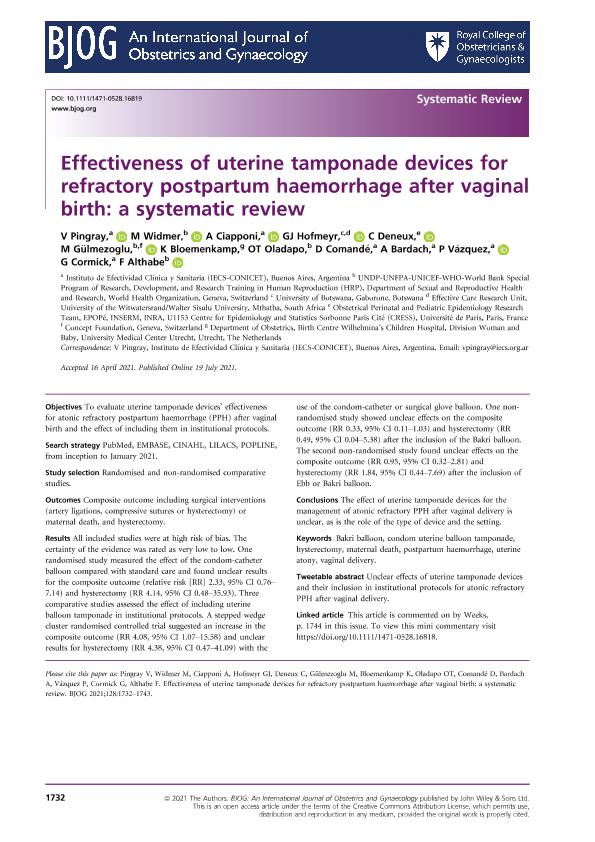Artículo
Effectiveness of uterine tamponade devices for refractory postpartum haemorrhage after vaginal birth: a systematic review
Pingray, María Verónica; Widmer, M.; Ciapponi, Agustín ; Hofmeyr, G.J.; Deneux, C.; Gülmezoglu, M.; Bloemenkamp, K.; Oladapo, O. T.; Comandé, D.; Bardach, Ariel Esteban
; Hofmeyr, G.J.; Deneux, C.; Gülmezoglu, M.; Bloemenkamp, K.; Oladapo, O. T.; Comandé, D.; Bardach, Ariel Esteban ; Vázquez, P.; Cormick, Gabriela
; Vázquez, P.; Cormick, Gabriela ; Althabe, Fernando
; Althabe, Fernando
 ; Hofmeyr, G.J.; Deneux, C.; Gülmezoglu, M.; Bloemenkamp, K.; Oladapo, O. T.; Comandé, D.; Bardach, Ariel Esteban
; Hofmeyr, G.J.; Deneux, C.; Gülmezoglu, M.; Bloemenkamp, K.; Oladapo, O. T.; Comandé, D.; Bardach, Ariel Esteban ; Vázquez, P.; Cormick, Gabriela
; Vázquez, P.; Cormick, Gabriela ; Althabe, Fernando
; Althabe, Fernando
Fecha de publicación:
06/2021
Editorial:
Wiley Blackwell Publishing, Inc
Revista:
BJOG - An International Journal of Obstetrics and Gynaecology
ISSN:
1470-0328
Idioma:
Inglés
Tipo de recurso:
Artículo publicado
Clasificación temática:
Resumen
Objectives: To evaluate uterine tamponade devices’ effectiveness for atonic refractory postpartum haemorrhage (PPH) after vaginal birth and the effect of including them in institutional protocols. Search strategy: PubMed, EMBASE, CINAHL, LILACS, POPLINE, from inception to January 2021. Study selection: Randomised and non-randomised comparative studies. Outcomes: Composite outcome including surgical interventions (artery ligations, compressive sutures or hysterectomy) or maternal death, and hysterectomy. Results: All included studies were at high risk of bias. The certainty of the evidence was rated as very low to low. One randomised study measured the effect of the condom-catheter balloon compared with standard care and found unclear results for the composite outcome (relative risk [RR] 2.33, 95% CI 0.76–7.14) and hysterectomy (RR 4.14, 95% CI 0.48–35.93). Three comparative studies assessed the effect of including uterine balloon tamponade in institutional protocols. A stepped wedge cluster randomised controlled trial suggested an increase in the composite outcome (RR 4.08, 95% CI 1.07–15.58) and unclear results for hysterectomy (RR 4.38, 95% CI 0.47–41.09) with the use of the condom-catheter or surgical glove balloon. One non-randomised study showed unclear effects on the composite outcome (RR 0.33, 95% CI 0.11–1.03) and hysterectomy (RR 0.49, 95% CI 0.04–5.38) after the inclusion of the Bakri balloon. The second non-randomised study found unclear effects on the composite outcome (RR 0.95, 95% CI 0.32–2.81) and hysterectomy (RR 1.84, 95% CI 0.44–7.69) after the inclusion of Ebb or Bakri balloon. Conclusions: The effect of uterine tamponade devices for the management of atonic refractory PPH after vaginal delivery is unclear, as is the role of the type of device and the setting. Tweetable abstract: Unclear effects of uterine tamponade devices and their inclusion in institutional protocols for atonic refractory PPH after vaginal delivery.
Archivos asociados
Licencia
Identificadores
Colecciones
Articulos(CIESP)
Articulos de CENTRO DE INVESTIGACIONES EN EPIDEMIOLOGIA Y SALUD PUBLICA
Articulos de CENTRO DE INVESTIGACIONES EN EPIDEMIOLOGIA Y SALUD PUBLICA
Citación
Pingray, María Verónica; Widmer, M.; Ciapponi, Agustín; Hofmeyr, G.J.; Deneux, C.; et al.; Effectiveness of uterine tamponade devices for refractory postpartum haemorrhage after vaginal birth: a systematic review; Wiley Blackwell Publishing, Inc; BJOG - An International Journal of Obstetrics and Gynaecology; 128; 11; 6-2021; 1732-1743
Compartir
Altmétricas



